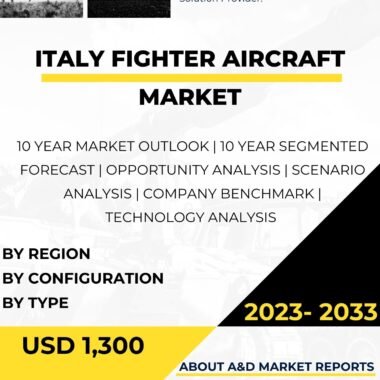Description
The Belgium fighter aircraft market is a significant segment within the country’s defense industry. Fighter aircraft are high-performance platforms designed for air-to-air combat and ground attack missions. Belgium recognizes the importance of advanced fighter aircraft in maintaining air superiority, protecting its airspace, and contributing to international security efforts.
The primary driver for the Belgium fighter aircraft market is the need for modern and capable platforms that can effectively address evolving defense challenges. Fighter aircraft provide critical capabilities such as air superiority, close air support, and precision strike capabilities. These platforms play a crucial role in deterring potential adversaries, conducting offensive and defensive operations, and providing support to ground forces.
Belgium’s domestic defense industry plays a crucial role in the development, production, and integration of fighter aircraft. Belgian companies, such as SABCA and FN Herstal, have expertise in aircraft manufacturing, avionics, and weapon systems, contributing to the country’s defense capabilities. These domestic capabilities foster innovation, create job opportunities, and contribute to the economic growth of the Belgium fighter aircraft market.
Collaborations with international partners and suppliers are also significant for the Belgium fighter aircraft market. Belgium often engages in partnerships with defense companies from NATO member states and other allied nations to access advanced fighter aircraft technologies, benefit from joint development programs, and ensure interoperability with allied forces. These collaborations enable Belgium to leverage global advancements in fighter aircraft and enhance its military capabilities.
Furthermore, Belgium’s participation in multinational defense initiatives influences the fighter aircraft market. Collaboration within NATO and other international defense cooperation programs fosters interoperability, joint training exercises, and the exchange of best practices. This cooperation ensures compatibility and enhances operational effectiveness when conducting joint military operations with allied forces.
The Belgium fighter aircraft market faces challenges such as technological advancements, affordability, and sustainment. Technological advancements in aircraft design, avionics, and weapon systems require continuous research and development efforts. The Belgium market needs to stay at the forefront of innovation to provide state-of-the-art fighter aircraft that meet evolving defense requirements.
Affordability is vital when purchasing and maintaining fighter jets. Belgium’s defense industry must carefully manage defense budgets and balance the cost of acquiring and operating fighter aircraft with the need for advanced capabilities. Cost-effective solutions, lifecycle management strategies, and international collaborations help address affordability challenges and ensure the availability of cutting-edge fighter aircraft.
Sustainment considerations are crucial for the successful operation of fighter aircraft. Belgium’s defense industry must ensure the availability of spare parts, maintenance capabilities, and logistics support to sustain the operational readiness of fighter aircraft. Effective sustainment practices, including predictive maintenance, supply chain management, and comprehensive training programs, are essential to maximize the operational availability of fighter aircraft.
In conclusion, the Belgium fighter aircraft market is a significant segment within the country’s defense industry. Fighter aircraft play a crucial role in maintaining air superiority, protecting airspace, and providing offensive and defensive capabilities. Domestic capabilities, collaborations with international partners, and Belgium’s participation in international defense initiatives drive the growth and development of the fighter aircraft market. As defense requirements evolve and technological advancements continue, the demand for advanced and capable fighter aircraft is expected to increase, fostering innovation, collaboration, and economic growth within the sector.




